In the intricate world of machinery and mechanical systems, bearings play a pivotal role, functioning as silent heroes that enable smooth movement, reduce friction, and ensure the longevity of various components.
Whether you’re a seasoned engineer or a curious enthusiast eager to delve into the heart of mechanical operations, this is the ultimate guide about bearings 2024.
What Are Bearings?
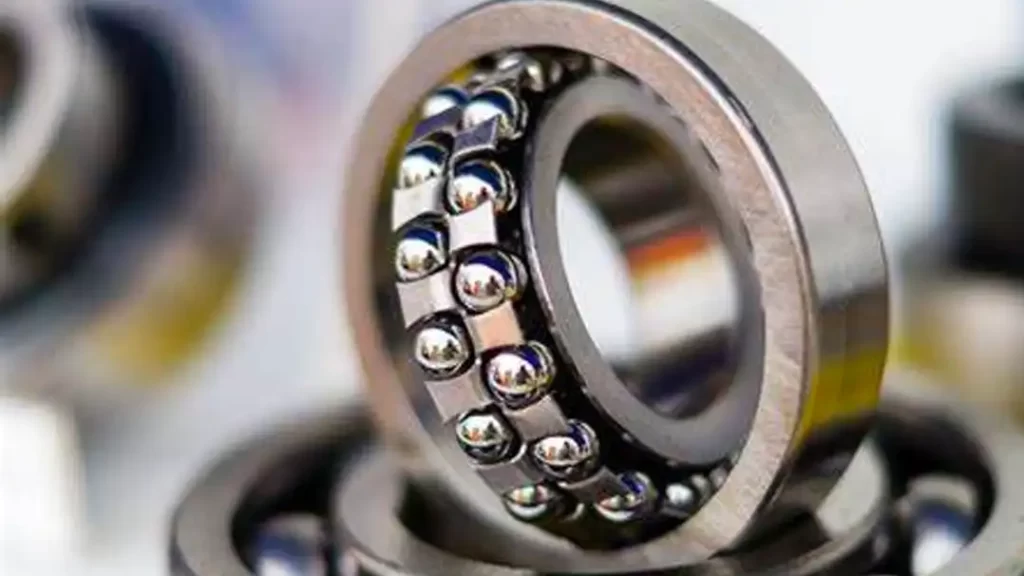
They play a crucial role in supporting loads, allowing rotational or linear motion, and ensuring the efficient functioning of machinery. Bearings come in different types, including plain bearings and rolling-element bearings.
What Is the History of Bearings?
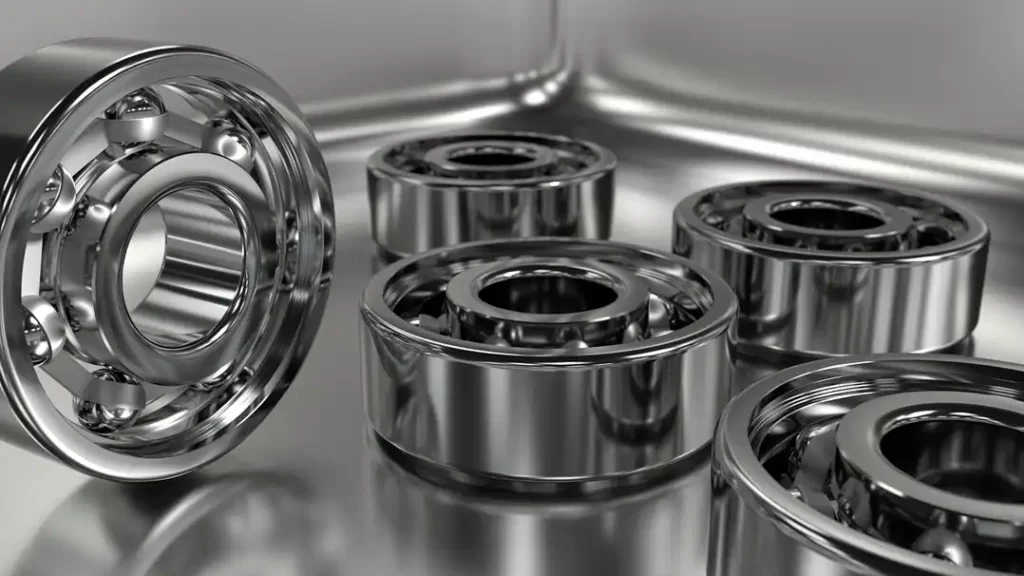
The history of bearings is a fascinating journey that spans centuries, marked by innovations and advancements in response to the evolving needs of various industries. The concept of reducing friction between moving parts dates back to ancient civilizations, where simple forms of lubrication, such as using sledges on lubricated wooden tracks, were employed. However, the formal development of bearings as we know them today took shape over time.
The earliest known bearings were likely wooden rollers or logs used in ancient Egyptian and Roman machinery. These rudimentary designs aimed at facilitating the movement of heavy objects with reduced friction. As civilizations progressed, so did the understanding of the principles behind bearing mechanisms.
One significant historical milestone is the emergence of wooden ball bearings in Renaissance-era clocks and early machinery. These early bearings paved the way for more sophisticated designs, eventually giving rise to metal bearings. By the 17th century, metal ball bearings were incorporated into rotating devices, such as the notable invention of the carriage wheel by Philip Vaughn.
The Industrial Revolution in the 18th and 19th centuries marked a turning point for bearing technology. Innovations in metallurgy and manufacturing processes led to the mass production of precision bearings. The development of anti-friction bearings, which utilized rolling elements like balls or rollers, further revolutionized machinery by significantly reducing friction and wear.
Throughout the 20th century, bearing technology continued to advance rapidly. The introduction of materials like chrome steel and advancements in manufacturing techniques enhanced the durability and performance of bearings. This era also saw the rise of specialized bearings for diverse applications, from automotive and aerospace to industrial machinery.
In recent decades, there has been a surge in the use of advanced materials such as ceramics and composites in bearing construction. These materials offer improved performance in terms of durability, corrosion resistance, and operating efficiency, especially in high-speed and high-temperature applications.
Today, bearings are integral components in countless machines and systems, supporting industries ranging from manufacturing and transportation to aerospace and robotics. The rich history of bearings reflects a continuous pursuit of efficiency, reliability, and technological excellence, making them indispensable in the functioning of the modern world.
What Are Bearings Made of?
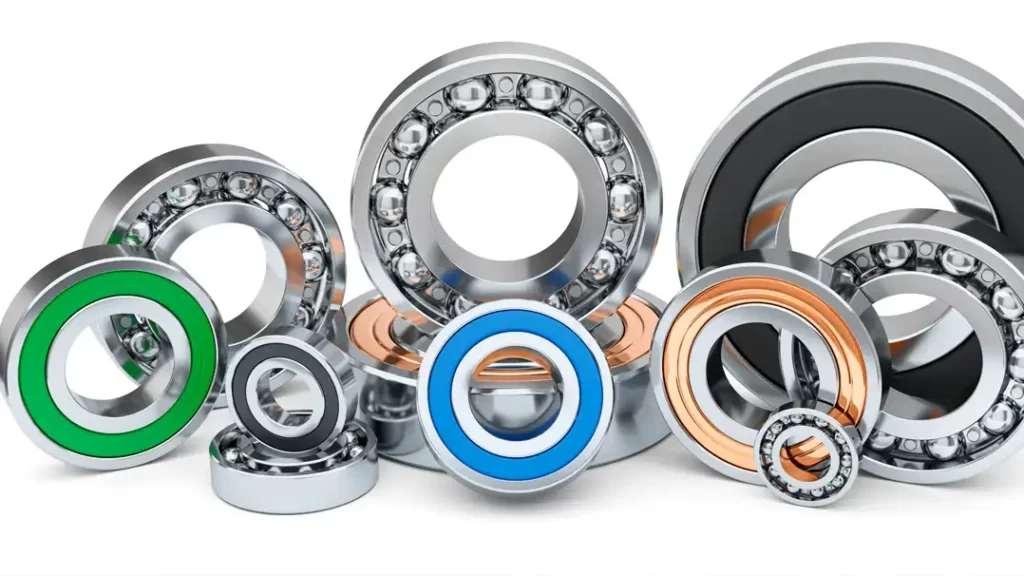
Bearings are made from a variety of materials, each chosen based on the specific requirements of the application. The choice of material depends on factors such as load capacity, speed, temperature, and environmental conditions. Here are some common materials used in bearing construction:
Steel:
High-carbon chrome steel is a traditional and widely used material for bearing components. It offers good hardness, strength, and wear resistance, making it suitable for a wide range of applications.
Ceramics:
Ceramic bearings are gaining popularity due to their exceptional properties. Silicon nitride (Si3N4) and zirconia (ZrO2) are common ceramic materials used in bearings. Ceramics offer high hardness, low friction, and resistance to corrosion, making them suitable for high-speed and high-temperature applications.
Stainless Steel:
Bearings made from stainless steel provide corrosion resistance and are suitable for applications where exposure to moisture or harsh environments is a concern. They are commonly used in industries such as food processing and medical equipment.
Plastics:
Various types of plastics, such as nylon, polyoxymethylene (POM), polytetrafluoroethylene (PTFE), and ultra-high-molecular-weight polyethylene (UHMWPE), are used to make plastic bearings. These materials are chosen for their self-lubricating properties, corrosion resistance, and suitability for light-load applications.
Bronze:
Bronze bearings are composed of copper and tin, sometimes with additional elements. They are known for their excellent wear resistance and ability to withstand heavy loads. Bronze bearings are often used in applications where steel bearings might corrode.
Composite Materials:
Composite bearings combine different materials to achieve specific performance characteristics. For example, a bearing might have a steel backing with a layer of PTFE for low friction and self-lubrication.
Ceramic-Coated Bearings:
In some cases, bearings have a ceramic coating applied to their surfaces. This coating can enhance durability, reduce friction, and provide resistance to wear.
Gemstones:
In high-end and precision applications, gemstones like sapphire are used in bearings. These materials offer exceptional hardness and wear resistance, making them suitable for applications where precision is critical.
The choice of bearing material depends on the application’s demands, including factors such as load capacity, speed, temperature, and environmental conditions. Advances in material science continue to bring new possibilities, allowing for the development of bearings with enhanced performance and longevity in various industrial and mechanical settings.
Bearing Types
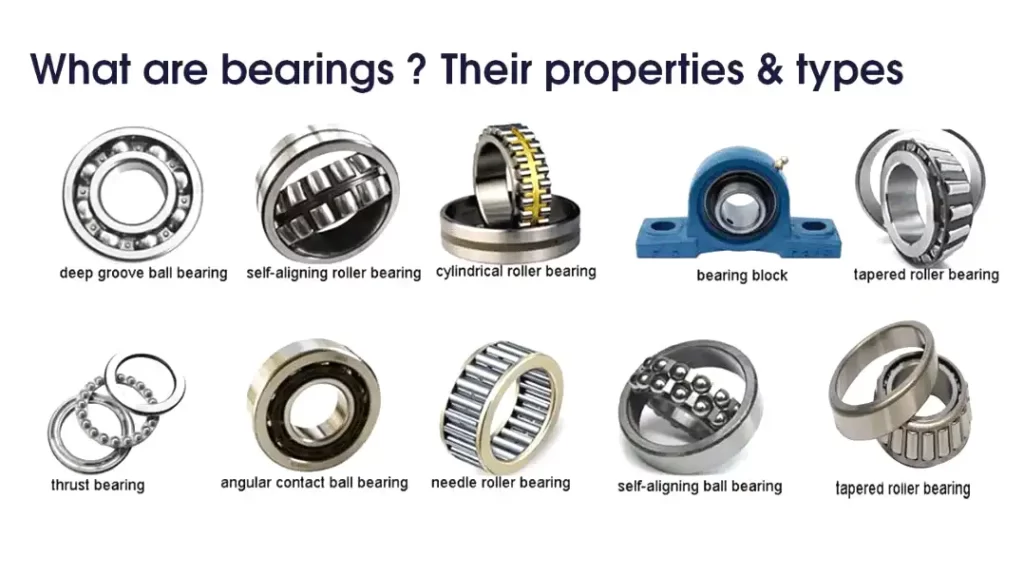
Bearings come in various types, each designed to meet specific application requirements. Here are some common types of bearings:
Ball Bearings:
These bearings use balls to reduce friction between the rotating and stationary components. They are versatile and suitable for various applications, including radial and thrust loads.
Roller Bearings:
Roller bearings use cylindrical, tapered, or spherical rollers to distribute loads. They are well-suited for heavy radial loads and moderate thrust loads, making them common in applications like conveyor systems and vehicle wheels.
Needle Bearings:
Needle bearings are a type of roller bearing with slender cylindrical rollers. They are compact and ideal for applications with limited radial space, such as in automotive transmissions.
Thrust Bearings:
Thrust bearings are designed to handle axial loads (force parallel to the shaft). They come in various configurations, including ball thrust bearings and roller thrust bearings, depending on the application’s requirements.
Spherical Bearings:
Spherical bearings accommodate misalignment and axial loads. They have a spherical inner and outer race, making them suitable for applications where shaft deflection or misalignment is expected.
Tapered Roller Bearings:
Tapered roller bearings handle both radial and axial loads. The rollers are tapered, allowing them to support thrust in one direction. They are commonly used in wheel bearings and gearboxes.
Plain Bearings (Bushings):
Plain bearings, also known as bushings, consist of a surface with no rolling elements. They rely on a sliding action between the moving and stationary parts and are often used in low-load and high-speed applications.
Angular Contact Bearings:
Angular contact bearings are designed to handle combined radial and axial loads. They have a specific contact angle between the races and the balls, making them suitable for applications like machine tool spindles.
Ceramic Bearings:
Ceramic bearings use ceramic balls or races, offering advantages such as increased durability, reduced friction, and resistance to corrosion. They are often used in high-performance or specialized applications.
Mounted Bearings:
Mounted bearings are pre-assembled units that include a bearing and housing. They simplify installation and are commonly used in applications like conveyor systems, agricultural machinery, and HVAC systems.
Choosing the right type of bearing depends on factors such as the load type, magnitude, speed, and the specific requirements of the application. Each type of bearing has its strengths and limitations, making proper selection crucial for optimal performance and longevity in diverse industrial and mechanical settings.
Roles of using bearings
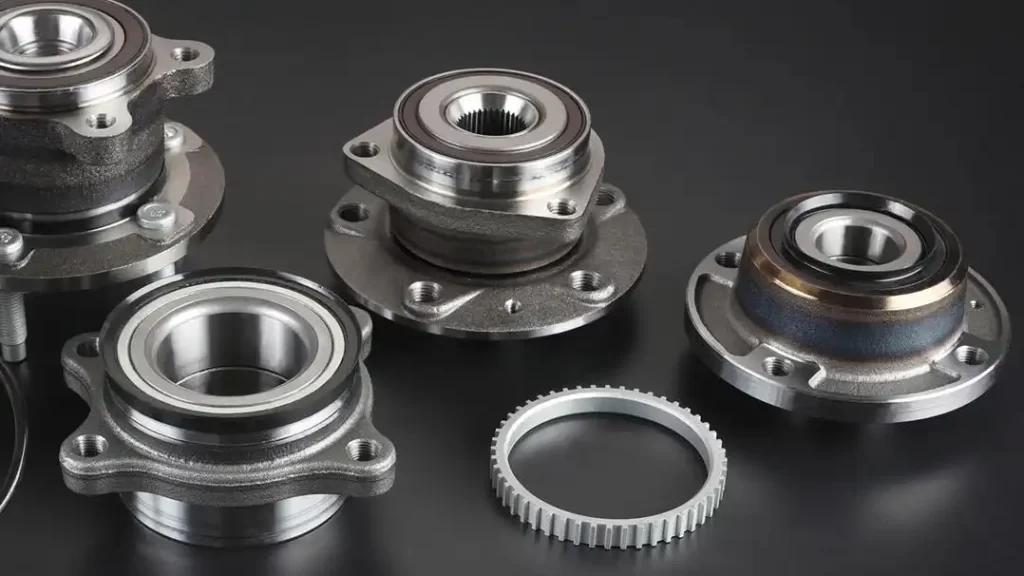
Here are some reasons why you need to use bearings for your project.
Bearings play a crucial role in various mechanical systems by facilitating smooth movement and reducing friction between moving parts. Their primary functions include:
Reducing Friction:
Bearings provide a low-friction interface between moving parts, allowing them to slide or rotate with minimal resistance. This reduces wear and tear on the components, leading to increased efficiency and longevity of the machinery.
Supporting Loads:
Bearings support the loads applied to the moving parts of a machine. They distribute the weight and forces evenly, preventing excessive stress on individual components. This is essential for maintaining the structural integrity of the machine.
Enabling Rotation or Linear Movement:
Bearings enable rotational or linear movement by allowing one component to move relative to another. This is crucial in various applications, such as wheels rotating on axles, gears turning, or linear motion in machinery.
Positioning Accuracy:
Precision bearings are designed to provide accurate positioning of components. This is particularly important in applications where precise alignment and control of movement are critical, such as in robotics, CNC machines, and other precision equipment.
Absorbing Shock and Vibration:
Bearings can help absorb shocks and vibrations generated during the operation of machinery. This is essential for preventing damage to sensitive components and ensuring the smooth functioning of the equipment.
Sealing and Containment:
In some applications, bearings also serve as seals to prevent the entry of contaminants like dust and moisture. This is crucial in environments where cleanliness is essential, such as in certain types of manufacturing processes.
Facilitating Lubrication:
Bearings require proper lubrication to reduce friction and wear. They are designed to retain lubricants and distribute them evenly to moving parts. This ensures smooth operation and prevents overheating.
Ease of Maintenance:
Bearings contribute to the ease of maintenance in machinery. Components that utilize bearings are often designed for accessibility, allowing for straightforward replacement or lubrication, thereby reducing downtime.
Temperature Management:
Bearings can help dissipate heat generated during operation, contributing to the overall temperature management of a system. This is particularly important in high-speed or heavy-duty applications where excess heat can lead to premature wear.
Journal Bearing vs Roller Bearing
Here’s a comparison table outlining the key differences between journal bearings and roller bearings:
| Feature | Journal Bearing | Roller Bearing |
|---|---|---|
| Contact Surface | Sliding contact between the shaft and the bearing surface | Rolling contact between the rolling elements and races |
| Friction | Generally higher friction due to sliding motion | Lower friction due to rolling motion |
| Load Capacity | Typically lower load capacity | Generally higher load capacity |
| Speed Limitation | Suitable for low to moderate speeds | Suitable for higher speeds |
| Application Range | Commonly used in heavy-duty applications | Widely used across various applications |
| Lubrication | Requires effective lubrication to minimize wear | Lubrication is essential but typically less critical |
| Alignment Sensitivity | More sensitive to misalignment | Tolerant to some degree of misalignment |
| Maintenance | May require more frequent maintenance due to wear | Generally lower maintenance requirements |
| Shock Absorption | Better shock absorption capabilities | Effective shock absorption, especially in roller thrust bearings |
| Cost | Cost-effective in many applications | Can be more expensive depending on design and materials |
It’s important to note that the choice between journal bearings and roller bearings depends on specific application requirements, including load, speed, precision, and maintenance considerations. Each type has its advantages and is selected based on the demands of the machinery or system in which it is employed.
Conclusion
In conclusion, bearings stand as the unsung heroes within the intricate machinery that propels our modern world.
From reducing friction and supporting loads to enabling precise movement, bearings play a critical role in ensuring the seamless operation and longevity of diverse mechanical systems.
As you embark on your journey of understanding these pivotal components, remember that the world of bearings is vast and continually evolving. Whether you’re an industry professional seeking optimal solutions or an enthusiast eager to explore the mechanics beneath the surface, the realm of bearings holds endless possibilities.
Should you have inquiries, need guidance, or are ready to explore the right bearings for your specific application, we welcome you to contact us. Our team is dedicated to providing expert assistance and finding the perfect bearings to suit your needs. Let’s enhance the efficiency and reliability of your machinery together. Welcome to the world of bearings, where precision meets performance. Contact us today to get started!

